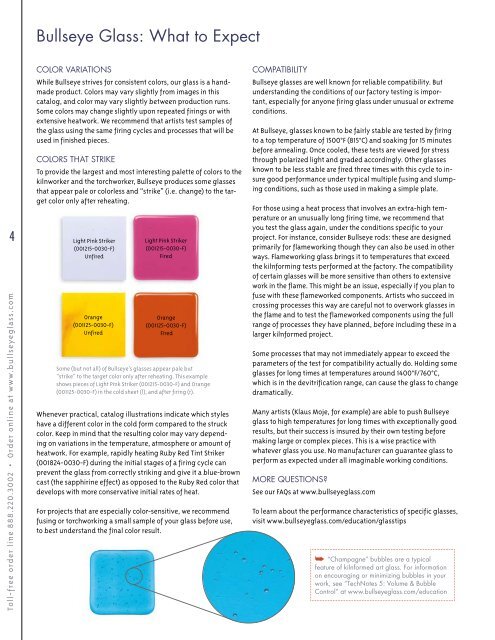Create successful ePaper yourself
Turn your PDF publications into a flip-book with our unique Google optimized e-Paper software.
Toll-free order line 888.220.3002 • Order online at www.bullseyeglass.com 4<br />
Bullseye <strong>Glas</strong>s: What to Expect<br />
COLOR vARIATIONS<br />
While Bullseye strives for consistent colors, our glass is a handmade<br />
product. Colors may vary slightly from images in this<br />
catalog, and color may vary slightly between production runs.<br />
Some colors may change slightly upon repeated firings or with<br />
extensive heatwork. We recommend that artists test samples of<br />
the glass using the same firing cycles and processes that will be<br />
used in finished pieces.<br />
COLORS ThAT STRIkE<br />
To provide the largest and most interesting palette of colors to the<br />
kilnworker and the torchworker, Bullseye produces some glasses<br />
that appear pale or colorless and “strike” (i.e. change) to the target<br />
color only after reheating.<br />
Light Pink Striker<br />
(001215-0030-F)<br />
Unfired<br />
Orange<br />
(001125-0030-F)<br />
Unfired<br />
Light Pink Striker<br />
(001215-0030-F)<br />
Fired<br />
Orange<br />
(001125-0030-F)<br />
Fired<br />
Some (but not all) of Bullseye’s glasses appear pale but<br />
“strike” to the target color only after reheating. This example<br />
shows pieces of Light Pink Striker (001215-0030-F) and Orange<br />
(001125-0030-F) in the cold sheet (l), and after firing (r).<br />
Whenever practical, catalog illustrations indicate which styles<br />
have a different color in the cold form compared to the struck<br />
color. Keep in mind that the resulting color may vary depending<br />
on variations in the temperature, atmosphere or amount of<br />
heatwork. For example, rapidly heating Ruby Red Tint Striker<br />
(001824-0030-F) during the initial stages of a firing cycle can<br />
prevent the glass from correctly striking and give it a blue-brown<br />
cast (the sapphirine effect) as opposed to the Ruby Red color that<br />
develops with more conservative initial rates of heat.<br />
For projects that are especially color-sensitive, we recommend<br />
fusing or torchworking a small sample of your glass before use,<br />
to best understand the final color result.<br />
COmPATIBILITy<br />
Bullseye glasses are well known for reliable compatibility. But<br />
understanding the conditions of our factory testing is important,<br />
especially for anyone firing glass under unusual or extreme<br />
conditions.<br />
At Bullseye, glasses known to be fairly stable are tested by firing<br />
to a top temperature of 1500°F (815°C) and soaking for 15 minutes<br />
before annealing. Once cooled, these tests are viewed for stress<br />
through polarized light and graded accordingly. Other glasses<br />
known to be less stable are fired three times with this cycle to insure<br />
good performance under typical multiple fusing and slumping<br />
conditions, such as those used in making a simple plate.<br />
For those using a heat process that involves an extra-high temperature<br />
or an unusually long firing time, we recommend that<br />
you test the glass again, under the conditions specific to your<br />
project. For instance, consider Bullseye rods: these are designed<br />
primarily for flameworking though they can also be used in other<br />
ways. Flameworking glass brings it to temperatures that exceed<br />
the kilnforming tests performed at the factory. The compatibility<br />
of certain glasses will be more sensitive than others to extensive<br />
work in the flame. This might be an issue, especially if you plan to<br />
fuse with these flameworked components. Artists who succeed in<br />
crossing processes this way are careful not to overwork glasses in<br />
the flame and to test the flameworked components using the full<br />
range of processes they have planned, before including these in a<br />
larger kilnformed project.<br />
Some processes that may not immediately appear to exceed the<br />
parameters of the test for compatibility actually do. holding some<br />
glasses for long times at temperatures around 1400°F/760°C,<br />
which is in the devitrification range, can cause the glass to change<br />
dramatically.<br />
Many artists (Klaus Moje, for example) are able to push Bullseye<br />
glass to high temperatures for long times with exceptionally good<br />
results, but their success is insured by their own testing before<br />
making large or complex pieces. This is a wise practice with<br />
whatever glass you use. no manufacturer can guarantee glass to<br />
perform as expected under all imaginable working conditions.<br />
mORE QUESTIONS?<br />
See our FAQs at www.bullseyeglass.com<br />
To learn about the performance characteristics of specific glasses,<br />
visit www.bullseyeglass.com/education/glasstips<br />
➥ “Champagne” bubbles are a typical<br />
feature of kilnformed art glass. for information<br />
on encouraging or minimizing bubbles in your<br />
work, see “TechNotes 5: volume & Bubble<br />
Control” at www.bullseyeglass.com/education


